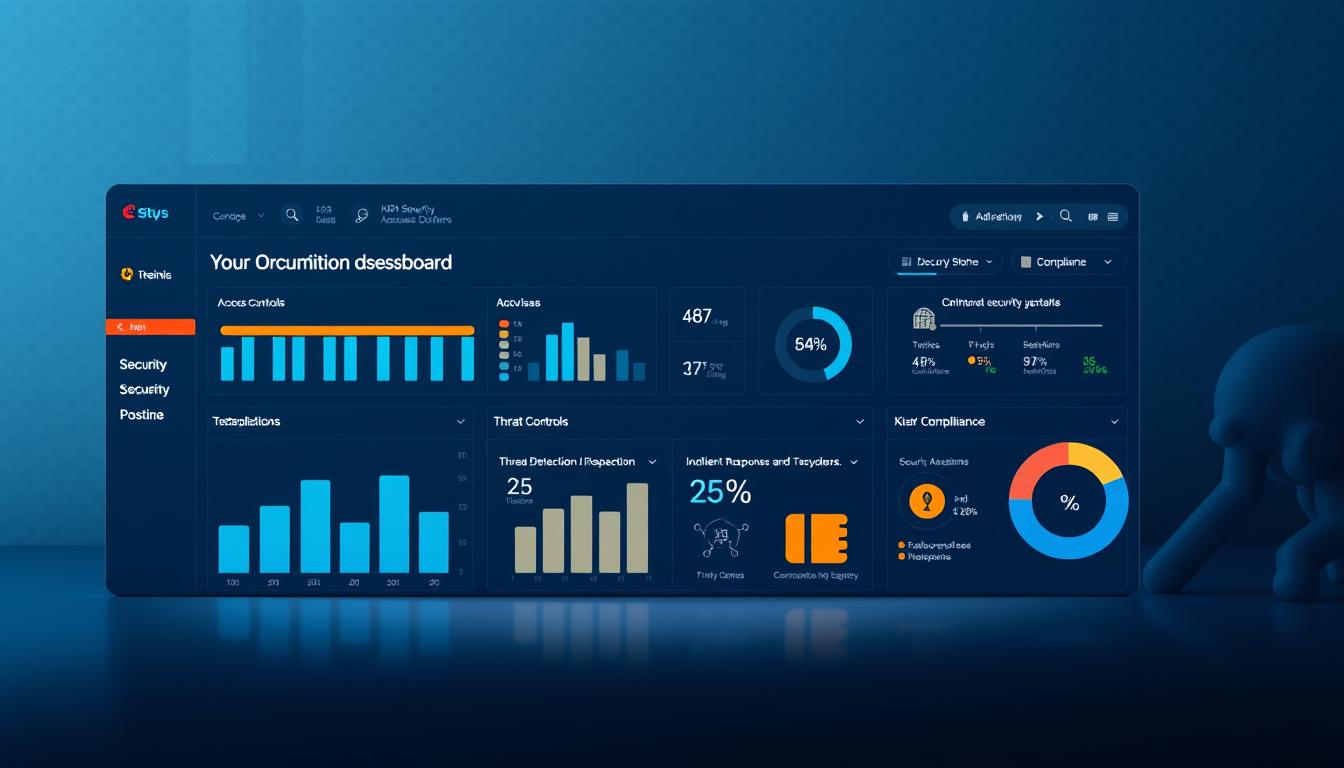In today’s rapidly evolving digital landscape, cybersecurity is no longer a luxury, but a necessity. As cyber threats become more sophisticated, it’s imperative for organizations to modernize their security approach to stay ahead.

Edit
Full screen
Delete
𝐑𝐞𝐝𝐞𝐟𝐢𝐧𝐢𝐧𝐠 𝐌𝐨𝐝𝐞𝐫𝐧 𝐎𝐫𝐠𝐚𝐧𝐢𝐳𝐚𝐭𝐢𝐨𝐧𝐚𝐥 𝐒𝐞𝐜𝐮𝐫𝐢𝐭𝐲
The traditional security measures are no longer sufficient to protect against the complex and dynamic threats. A modern organizational security strategy involves a proactive and robust security posture that can detect, respond, and prevent cyber attacks.
By modernizing your organization’s security approach, you can ensure the protection of your assets, data, and reputation. It’s time to rethink your security strategy and stay ahead of the evolving cyber threats.
Key Takeaways
- Modernizing your security approach is crucial in today’s digital landscape.
- A robust security posture involves detecting, responding, and preventing cyber attacks.
- A proactive security strategy can protect your organization’s assets, data, and reputation.
- Staying ahead of evolving cyber threats requires a modern organizational security approach.
- A modern security strategy is essential for protecting against complex and dynamic threats.
The Evolving Landscape of Organizational Security
The ever-changing landscape of organizational security demands constant vigilance. As technology continues to advance, organizations face a multitude of security challenges that require adaptive and robust security measures.
Current Security Challenges Facing Organizations
Organizations today encounter various security challenges that threaten their operations and data. Two significant challenges are remote work security implications and supply chain vulnerabilities.
Remote Work Security Implications
Remote work has become a norm, expanding the attack surface for organizations. Ensuring secure remote access and protecting against data breaches are critical concerns.
Supply Chain Vulnerabilities
Supply chain vulnerabilities pose a significant risk, as attackers often target weaker links in the supply chain to gain access to more secure targets. Securing the supply chain requires vetting third-party vendors and implementing robust security protocols.
The Impact of Digital Transformation on Security
Digital transformation has revolutionized organizational operations, but it also introduces new security risks. Key areas of concern include cloud migration security considerations and IoT security.
Cloud Migration Security Considerations
As organizations migrate to the cloud, they must address security concerns such as data privacy, access controls, and compliance with regulatory requirements.
IoT and Expanded Attack Surfaces
The proliferation of IoT devices has expanded the attack surface, making it essential for organizations to implement robust IoT security measures to prevent unauthorized access and data breaches.
Why Traditional Security Models Are Failing
In today’s digital age, traditional security models are proving inadequate against the backdrop of escalating cyber attacks. The once-effective security measures are now struggling to keep up with the evolving threat landscape.
Limitations of Perimeter-Based Security
Perimeter-based security has been the cornerstone of organizational security for decades. However, its limitations are becoming increasingly apparent.
The Disappearing Network Boundary
The traditional network perimeter is disappearing due to the adoption of cloud services, mobile devices, and remote work. This shift has rendered the traditional perimeter-based security model less effective.
Identity as the New Perimeter
As the network boundary disappears, identity has become the new perimeter. Identity-based attacks are on the rise, making it crucial for organizations to focus on identity security.
“The new perimeter is identity. You can’t just secure the network; you need to secure the identities that access your data.” –
Security Expert
The Growing Sophistication of Cyber Threats
Cyber threats are becoming increasingly sophisticated, posing significant challenges to traditional security models.
Advanced Persistent Threats (APTs)
APTs are complex, targeted attacks that can evade traditional security measures. They require a more proactive and sophisticated security approach.
Ransomware Evolution
Ransomware has evolved significantly, with attackers now using more sophisticated tactics, such as double extortion. This evolution underscores the need for advanced security measures.
| Threat Type | Characteristics | Impact |
| APTs | Targeted, sophisticated, multi-stage attacks | Significant data breaches, financial loss |
| Ransomware | Malware that encrypts data, demands ransom | Data loss, financial loss, operational disruption |
Edit
Delete
Redefining Modern Organizational Security
Modern organizational security requires a paradigm shift from traditional reactive measures to proactive strategies that anticipate and mitigate potential threats. This shift is crucial in today’s fast-paced digital landscape, where threats are becoming increasingly sophisticated.
From Reactive to Proactive Security Postures
The traditional reactive approach to security is no longer sufficient. Organizations must adopt proactive security measures that enable them to anticipate and respond to threats before they cause significant damage.
Threat Hunting and Intelligence
Threat hunting involves proactively searching for threats that may have evaded traditional security measures. This is complemented by threat intelligence, which provides insights into potential threats and helps organizations prepare accordingly.
Continuous Security Monitoring
Continuous security monitoring is essential for detecting and responding to security incidents in real-time. This involves monitoring network traffic, system logs, and other security-related data to identify potential threats.
The Zero Trust Security Model
The Zero Trust security model is a proactive security approach that assumes that threats can come from both inside and outside the organization. It involves verifying the identity and permissions of users and devices before granting access to sensitive resources.
Core Principles of Zero Trust
The core principles of Zero Trust include least privilege access, micro-segmentation, and continuous verification. These principles help to minimize the attack surface and prevent lateral movement in case of a breach.
Implementation Roadmap
Implementing Zero Trust involves several steps, including identifying sensitive resources, mapping out user and device access, and implementing least privilege access controls. A well-planned implementation roadmap is crucial for a successful transition.
| Security Approach | Traditional | Zero Trust |
| Access Control | Perimeter-based | Least Privilege |
| Threat Assumption | Trust by Default | Verify by Default |
| Monitoring | Periodic | Continuous |
Assessing Your Organization’s Security Maturity
Understanding your organization’s security maturity is crucial in today’s evolving threat landscape. It involves evaluating your current security posture and identifying areas for improvement.
Security Maturity Models Explained
Security maturity models provide a framework for organizations to assess and enhance their security practices. These models help in understanding the current state of security and in planning for future improvements.
NIST Cybersecurity Framework
The NIST Cybersecurity Framework is a widely adopted model that provides guidelines for managing and reducing cybersecurity risk. It consists of five core functions: Identify, Protect, Detect, Respond, and Recover.
CMMC and Other Industry Models
CMMC (Cybersecurity Maturity Model Certification) is another significant model, particularly for organizations dealing with the Department of Defense. Other industry-specific models also exist, catering to the unique needs of different sectors.
Conducting a Comprehensive Security Assessment
A comprehensive security assessment is vital for understanding an organization’s security maturity. This involves evaluating existing security controls and practices.
Gap Analysis Methodologies
Gap analysis is a critical component of a security assessment. It involves identifying the gaps between the current security state and the desired state as per the chosen maturity model.
Interpreting Assessment Results
Interpreting the results of a security assessment requires understanding the identified gaps and prioritizing remediation efforts. This step is crucial for developing a roadmap to improve security maturity.
| Security Maturity Level | NIST Cybersecurity Framework | CMMC |
| Level 1 | Basic Cybersecurity Hygiene | Basic Cyber Hygiene |
| Level 2 | Enhanced Cybersecurity Hygiene | Intermediate Cyber Hygiene |
| Level 3 | Organizational Cybersecurity Management | Good Cyber Hygiene |

Edit
Full screen
Delete
security maturity assessment
Building a Risk-Based Security Strategy
In today’s rapidly evolving threat landscape, building a risk-based security strategy is crucial for organizational survival. This approach enables organizations to proactively identify and mitigate potential security risks, ensuring the protection of critical assets.
Identifying Critical Assets and Vulnerabilities
The first step in developing a risk-based security strategy is to identify critical assets and vulnerabilities. This involves conducting a thorough asset inventory and vulnerability assessment to understand the organization’s security posture.
Asset Inventory Best Practices
Effective asset inventory management involves maintaining an up-to-date record of all organizational assets, including hardware, software, and data. This can be achieved through automated asset discovery tools and regular inventory audits.
Vulnerability Management Programs
A robust vulnerability management program is essential for identifying and remediating potential security vulnerabilities. This includes regular vulnerability scanning and patch management.
Prioritizing Security Investments Based on Risk
Once critical assets and vulnerabilities are identified, organizations must prioritize security investments based on risk. This involves quantifying risk and conducting cost-benefit analyses for security controls.
Risk Quantification Methods
Risk quantification methods, such as risk assessment frameworks, help organizations understand the likelihood and potential impact of security breaches.
Cost-Benefit Analysis for Security Controls
A cost-benefit analysis is crucial for determining the effectiveness of security controls and ensuring that security investments are aligned with organizational risk tolerance.
| Risk Quantification Method | Description | Benefits |
| Risk Assessment Frameworks | Structured approaches to assessing risk | Comprehensive risk understanding |
| Threat Modeling | Identifying potential threats and vulnerabilities | Proactive risk mitigation |
| Cost-Benefit Analysis | Evaluating the cost-effectiveness of security controls | Informed security investments |
Developing Measurable Security Objectives
To ensure the effectiveness of a risk-based security strategy, organizations must develop measurable security objectives. This includes establishing security KPIs and metrics and implementing executive reporting frameworks.
Security KPIs and Metrics
Security KPIs and metrics provide insights into an organization’s security performance, enabling data-driven decision-making.
Executive Reporting Frameworks
Executive reporting frameworks facilitate the communication of security information to stakeholders, ensuring that security objectives are aligned with organizational goals.
Implementing Cloud-Native Security Solutions
As organizations increasingly adopt cloud-native technologies, implementing robust security solutions becomes paramount. Cloud-native security is designed to protect cloud-native applications and infrastructure from cyber threats.
Securing Multi-Cloud Environments
Multi-cloud environments introduce complexity and increase the attack surface. To secure these environments, organizations must implement comprehensive security measures.
Cloud Security Posture Management
Cloud Security Posture Management (CSPM) is a critical component of multi-cloud security. CSPM solutions provide real-time monitoring and compliance management, helping organizations identify and remediate security risks.
Identity and Access Management in the Cloud
Identity and Access Management (IAM) is vital in the cloud, ensuring that only authorized users have access to resources. Implementing robust IAM policies and using multi-factor authentication can significantly reduce the risk of unauthorized access.

Edit
Full screen
Delete
cloud-native security
Container and Kubernetes Security Best Practices
Containers and Kubernetes have become the backbone of modern cloud-native applications. Securing these technologies is essential to prevent potential breaches.
Securing the Container Pipeline
Securing the container pipeline involves implementing security measures at every stage, from development to deployment. This includes using secure base images, scanning for vulnerabilities, and ensuring compliance with security policies.
Runtime Protection Strategies
Runtime protection strategies are crucial for detecting and responding to threats in real-time. Implementing monitoring tools and anomaly detection can help identify potential security incidents before they cause harm.
Leveraging AI and Automation for Enhanced Security
In the quest for robust security, organizations are increasingly turning to AI and automation to bolster their defenses against evolving cyber threats. This shift is driven by the need for more sophisticated and responsive security measures that can keep pace with the complexity of modern cyber attacks.
AI-Powered Threat Detection and Response
AI-powered threat detection represents a significant advancement in organizational security. By leveraging machine learning algorithms and behavioral analytics, organizations can identify and respond to threats more effectively.
Machine Learning for Anomaly Detection
Machine learning enables systems to learn from data, identifying patterns and anomalies that may indicate a security threat. This capability is crucial for detecting unknown threats that traditional security measures might miss.
Behavioral Analytics and User Entity Behavior Analytics
Behavioral analytics and User Entity Behavior Analytics (UEBA) involve monitoring user behavior to identify potential security risks. By establishing a baseline of normal behavior, these systems can flag unusual activities that may signal a security breach.
Security Orchestration, Automation, and Response (SOAR)
SOAR solutions integrate security tools and automate incident response workflows, enhancing the efficiency and effectiveness of security operations.
Automating Incident Response Workflows
Automating incident response workflows enables organizations to respond to security incidents more quickly and consistently. This automation reduces the time and effort required to manage incidents, allowing security teams to focus on more strategic tasks.
Integration with Existing Security Tools
SOAR solutions can integrate with a wide range of security tools, providing a unified platform for managing security operations. This integration enhances visibility and control, enabling more effective security management.
| Feature | AI-Powered Threat Detection | SOAR |
| Primary Function | Identify and respond to threats using AI | Orchestrate and automate security incident response |
| Key Benefits | Enhanced threat detection, faster response times | Streamlined incident response, improved security operations efficiency |
Developing a Strong Security Culture
In today’s digital landscape, fostering a culture of security within an organization is more important than ever. A robust security culture is not just about implementing the right technologies, but also about ensuring that every employee understands their role in maintaining security.
Security Awareness Training Programs
Effective security awareness training is crucial for educating employees about potential threats and the best practices to avoid them. Such programs should be comprehensive and engaging.
Tailoring Training to Different Roles
It’s essential to tailor security awareness training to different roles within the organization. For instance, employees handling sensitive data require more in-depth training compared to those with limited access.
Measuring Training Effectiveness
To ensure the training is effective, organizations should measure its impact through quizzes, feedback forms, and monitoring changes in employee behavior.
Encouraging Security Ownership Across Departments
Security is everyone’s responsibility. Encouraging security ownership across various departments can significantly enhance an organization’s overall security posture.
Security Champions Programs
Implementing security champions programs, where selected employees act as security advocates within their teams, can foster a culture of security.
DevSecOps Cultural Shift
Adopting a DevSecOps approach integrates security into the development process, ensuring that security is considered at every stage.
Measuring and Improving Security Behaviors
Regularly measuring and improving security behaviors is vital. This can be achieved through various methods, including phishing simulation campaigns and incentivizing security best practices.
Phishing Simulation Campaigns
Phishing simulations help assess employees’ awareness and response to phishing attempts, providing insights into areas needing improvement.
Incentivizing Security Best Practices
Incentives can motivate employees to adhere to security best practices, thereby enhancing the overall security culture.
| Security Culture Aspect | Description | Benefits |
| Security Awareness Training | Educates employees on security threats and best practices | Reduces risk of security breaches |
| Security Ownership | Encourages employees to take responsibility for security | Enhances overall security posture |
| DevSecOps | Integrates security into the development process | Improves security at every development stage |
Compliance and Regulatory Considerations in Modern Security
Navigating the intricate world of compliance and regulatory requirements is a key aspect of modern security. As organizations continue to evolve and expand their digital footprint, understanding and adhering to various regulatory standards becomes increasingly crucial.
Navigating Industry-Specific Regulations
Different industries are subject to a variety of regulations that govern how they handle data and implement security measures. Understanding these regulations is the first step towards compliance.
GDPR, CCPA, and Data Privacy Regulations
Regulations like the General Data Protection Regulation (GDPR) and the California Consumer Privacy Act (CCPA) have set new standards for data privacy. Organizations must ensure they are compliant with these regulations to avoid hefty fines and reputational damage.
Industry-Specific Requirements
Industries such as healthcare and finance have their own set of regulations, including HIPAA and PCI DSS, respectively. These regulations dictate how sensitive information should be handled and secured.
| Regulation | Industry | Key Requirements |
| GDPR | General | Data protection, consent, breach notification |
| HIPAA | Healthcare | Protected health information, privacy, security |
| PCI DSS | Finance | Payment card information, security standards |
Building Security Programs That Exceed Compliance Requirements
While compliance is mandatory, it’s equally important to build security programs that go beyond mere compliance. This proactive approach not only ensures regulatory adherence but also enhances overall security posture.
Compliance as a Baseline, Not a Goal
Viewing compliance as a baseline rather than the ultimate goal allows organizations to continuously improve their security measures. This mindset shift is crucial for staying ahead of emerging threats.
Continuous Compliance Monitoring
Continuous monitoring of compliance is essential in today’s fast-paced regulatory environment. Regular audits and assessments help organizations stay compliant and identify areas for improvement.
Conclusion: Future-Proofing Your Security Approach
As organizations continue to navigate the complexities of the digital landscape, future-proofing their security approach is crucial. A modern security approach is no longer a luxury, but a necessity. By adopting a proactive cybersecurity strategy, organizations can stay ahead of evolving threats and protect their critical assets.
The key to a robust cybersecurity strategy lies in its ability to adapt to the ever-changing threat landscape. This involves implementing a risk-based security strategy, leveraging AI and automation, and fostering a strong security culture. By doing so, organizations can ensure their security posture is aligned with their business objectives.
Future-proofing security requires a continuous effort to stay informed about emerging threats and technologies. By prioritizing a modern security approach and investing in a comprehensive cybersecurity strategy, organizations can safeguard their future and maintain the trust of their customers and stakeholders.
FAQ
What are the key challenges in modernizing an organization’s security approach?
Organizations face challenges such as remote work security implications, supply chain vulnerabilities, and the impact of digital transformation on security, including cloud migration and IoT.
Why are traditional security models failing to protect organizations?
Traditional security models are failing due to their limitations, particularly perimeter-based security, and the growing sophistication of cyber threats, including Advanced Persistent Threats (APTs) and ransomware evolution.
What is the Zero Trust security model, and how can it benefit organizations?
The Zero Trust security model is a proactive security posture that assumes no user or device is trustworthy by default. It benefits organizations by providing a robust security framework that adapts to the evolving threat landscape.
How can organizations assess their security maturity?
Organizations can assess their security maturity using models such as the NIST Cybersecurity Framework and CMMC, and by conducting comprehensive security assessments, including gap analysis methodologies and interpreting assessment results.
What is a risk-based security strategy, and how can it be implemented?
A risk-based security strategy involves identifying critical assets and vulnerabilities, prioritizing security investments based on risk, and developing measurable security objectives. It can be implemented by using risk quantification methods, cost-benefit analysis for security controls, and security KPIs and metrics.
How can AI and automation enhance an organization’s security?
AI and automation can enhance security through AI-powered threat detection and response, and Security Orchestration, Automation, and Response (SOAR), which automates incident response workflows and integrates with existing security tools.
What is the importance of developing a strong security culture within an organization?
Developing a strong security culture is crucial as it encourages security ownership across departments, improves security behaviors, and reduces the risk of security breaches through security awareness training programs and security champions programs.
How can organizations navigate industry-specific regulations and compliance requirements?
Organizations can navigate industry-specific regulations by understanding requirements such as GDPR, CCPA, HIPAA, and PCI DSS, and building security programs that exceed compliance requirements, with a focus on continuous compliance monitoring.
What are the best practices for securing multi-cloud environments and container/Kubernetes security?
Best practices include cloud security posture management, identity and access management in the cloud, securing the container pipeline, and runtime protection strategies to ensure robust cloud-native security.
How can organizations future-proof their security approach?
Organizations can future-proof their security approach by staying informed about evolving threats, adopting proactive security postures like Zero Trust, leveraging AI and automation, and maintaining a strong security culture and compliance posture.

